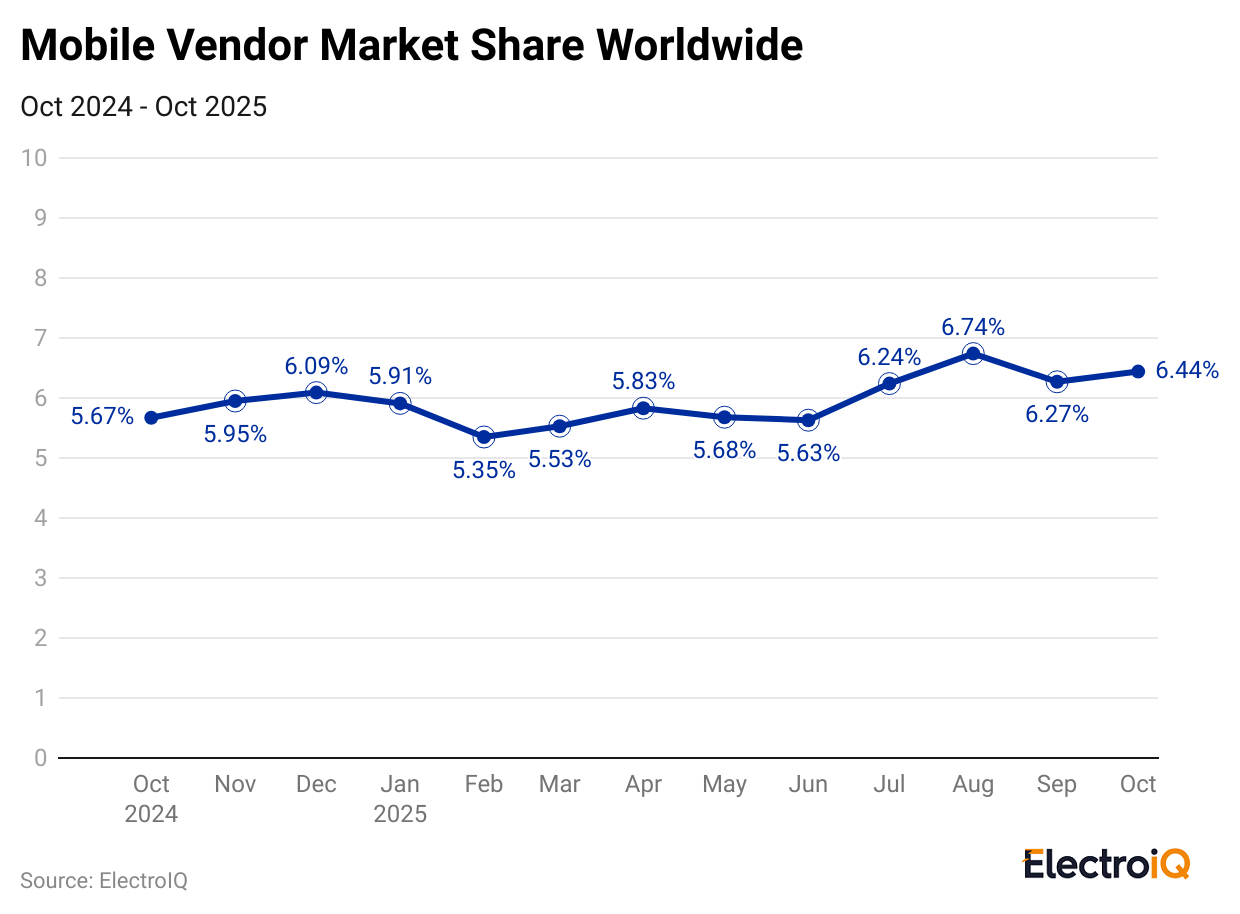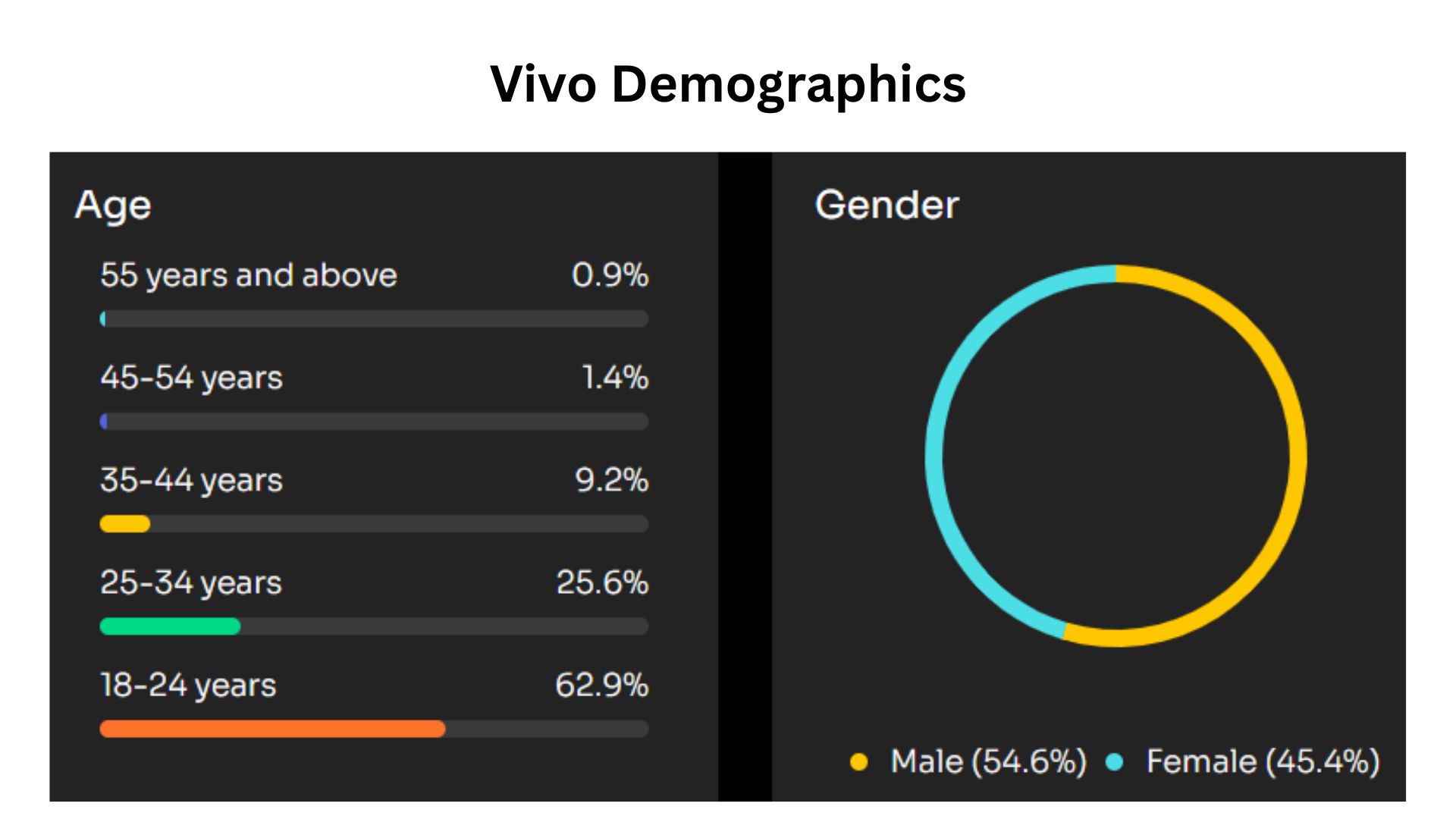Vivo Statistics By Market Share, Revenue, Trends, Insights And Facts(2025)
Updated · Nov 06, 2025

Table of Contents
- Introduction
- Editor’s Choice
- About Vivo
- General Vivo Statistics
- Vivo’s Financial Report Analysis
- Global Smartphone Shipment and Market Share of Vivo Statistics
- Vivo’s Mobile Vendor Market Share Statistics
- By Region
- By Country
- Vivo’s Top Smartphones Analysis of 2025
- Vivo Smartphone Users Statistics
- Vivo’s Sustainability Impacts
- Conclusion
Introduction
Vivo Statistics: Vivo was founded in 2009 and is based in Dongguan, China. The company builds smartphones sold in more than 60 countries. As part of the BBK Electronics family alongside Oppo, Realme, and OnePlus, Vivo has become known for practical technology that people actually use. Vivo brought features like in-screen fingerprint readers, fast charging, and gimbal-style camera stabilization into regular phones. The company produces phones that are easy to use, visually appealing, and capable of taking great photos.
Their products are supported by ongoing research and rigorous testing to ensure their reliability. Because it offers both affordable and high-end models, Vivo appeals to a wide range of buyers. Vivo has become a major global brand because of its stylish design, reliable performance, and innovative camera features.
Editor’s Choice
- On October 30, 2025, Vivo recorded USD 2.76 billion in revenue, a 6.5% increase from the previous year, and reported a net income of USD 352 million, representing a 13.3% rise from the same period in the previous year.
- In April 2025, Vivo entered Brazil but used the brand name Jovi there because the name “Vivo” is already used by Telefónica’s telecom company in that country.
- In the first quarter of 2025, Vivo sold approximately 22.9 million smartphones worldwide, accounting for around 8% of the global smartphone market.
- In October 2025, Vivo’s global market share for mobile devices was 6.44%, an increase from the previous month’s share of 6.27%.
- According to Statcounter, as of October 2025, Vivo’s mobile market share was highest in Asia at 10.94%.
- Oppo’s mobile market share in India was 17.62%.
- Vivo’s market share of smartphones in Asia was around 10.9%.
- According to Omdia’s Smartphone Market Pulse report for Q3 2025, Vivo shipped around 9.7 million smartphones in India, securing a 20% market share.
- In Q3 2025, Vivo was the top brand, shipping about 11.8 million units and capturing a 19% market share.
- According to Start.io’s 2025 data, about 62.9% of Vivo smartphone users in India are aged 18 to 24 years.
- Vivo released its 4th Sustainability Report in 2025 and notes facility energy-efficiency gains (one site reports approximately 40% lower energy use versus similar facilities).
About Vivo
| Metrics | Description |
|
Company Name |
Vivo Mobile Communication Co., Ltd. |
| Headquarters |
Dongguan, Guangdong, China |
|
Founded |
May 22 2009 |
|
Founders |
Shen Wei and Duan Yongping |
| Area served |
Worldwide |
|
Owner |
BBK Electronics |
| Key people |
Shen Wei (CEO); Baishan Hu (EVP & COO); Spark Ni (SVP & CMO); Yujian Shi (SVP & CTO) |
|
Products |
Smartphones, software, and online services |
| Employees |
About 40,000 (as of 2022) |
|
Subsidiaries |
iQOO and Jovi |
| Website |
vivo.com |
General Vivo Statistics
- The Vivo X60 series introduced the first Vivo-Zeiss co-engineered imaging system, and Vivo and Zeiss established the Vivo Zeiss Imaging Lab to collaborate on mobile camera research and development for Vivo’s flagship phones.
- In 2023, Vivo ranked among the world’s top five smartphone manufacturers, holding approximately 10% of the global market share.
- In April 2021, three pallets of Vivo phones caught fire at Hong Kong International Airport, resulting in a temporary ban on shipping Vivo phones by air through Hong Kong.
- In June 2022, Vivo entered the Guinness World Records for the “Longest Video” with the Vivo X Fold, which was folded over 300,000 times, producing a clip lasting 270 hours (approximately 11 days and 6 hours).
- In November 2023, Vivo launched BlueOS, an open-source distributed operating system for IoT devices and wearables, and showed it on the Vivo Watch 3.
- In December 2024, Dixon Technologies announced plans to form a joint venture with Vivo.
- In April 2025, Vivo entered Brazil but used the brand name Jovi there because the name “Vivo” is already used by Telefónica’s telecom company in that country.
Vivo’s Financial Report Analysis
- On October 30, 2025, Vivo recorded USD 2.76 billion in revenue, a 6.5% increase from the previous year, and reported a net income of USD 352 million, representing a 13.3% rise from the same period in the previous year.
- EBITDA reached USD 1.20 billion, representing a 9.0% increase, the highest rise in the past two years, with a margin of 43.4%.
- Vivo closed the quarter with 116.6 million total accesses, a 1.2% increase, including 102.9 million mobile users, a 1.4% rise.
- Mobile revenue climbed 5.5% to USD 1.79 billion, supported by postpaid growth of 8.0% to USD 1.55 billion, with 69.8 million postpaid users (+7.3%).
- The average revenue per user (ARPU) stood around USD 5.80, up 3.9% year-over-year.
- Device and electronics sales increased 2.8% to USD 162 million, with 95% of the revenue coming from 5G smartphones.
- Fixed-line revenue reached USD 814 million, up 9.6%, driven by fibre revenue of USD 370 million, which increased 10.6%.
- Fibre subscribers jumped 52.7% to 3.2 million, and total fibre connections reached 7.6 million, up 12.7%.
- Corporate digital services generated USD 259 million, marking a 22.8% rise.
- Investments grew 4.3% to USD 481 million, expanding 5G coverage to 683 cities and reaching 66.7% of the population. Meanwhile, the fibre network was extended to 30.5 million homes, representing a 7.6% increase in coverage.
- In the first quarter of 2025, Vivo sold approximately 22.9 million smartphones worldwide, accounting for around 8% of the global smartphone market.
- A report published by factodata.com indicates that in the first quarter of 2024, Vivo shipped 27.1 million smartphones worldwide, resulting in an estimated 8.2% share of the global smartphone market.
Furthermore, in previous years, the Vivo’s analysis is mentioned in the table below:
| Date | Shipments (million) | Market Share |
| Q1, 2023 | 20.9 | 8% |
| Q1, 2022 | 25.1 | 8% |
| Q1, 2021 | 36 | 10% |
| Q1, 2020 | 24.8 | 9% |

- The above image shows that in October 2025, Vivo’s global market share for mobile devices was 6.44%, an increase from the previous month’s share of 6.27%.
Furthermore, Vivo’s previous month’s mobile market share in 2025 is stated below:
| Months | Market Share |
| August | 6.74% |
| July | 6.24% |
| June | 5.63% |
| May | 5.68% |
| April | 5.83% |
| March | 5.53% |
| February | 5.35% |
| January | 5.91% |
By Region
- According to Statcounter, as of October 2025, Vivo’s mobile market share was highest in Asia at 10.94%.
- Other regions follow North America (0.5%) and Oceania (0.31%)
By Country
- As of October 2025, Oppo’s mobile market share in India was 17.62%.
- Meanwhile, Germany accounted for only 0.6% of the market share, followed by the United States (0.46%) and Canada (0.31%).
Vivo Smartphone Market Share in Asia
- As of October 2025, Vivo’s market share of smartphones in Asia was around 10.9%, according to StatCounter.
- Additionally, Vivo’s market share in the previous years was 11% in 2024, followed by 10% in 2023, 10.8% in 2022, 11.5% in 2021, 12% in 2020, and 8.5% in 2019.
Vivo’s Smartphone Market Statistics in India
- Omdia’s Q3 2025 report indicates that Vivo shipped approximately 9.7 million phones in India, securing a 20% market share.
- That’s up from 8.2 million phones and a 17% share in Q3 2024, with a 19% increase compared to the same period last year.
In China
- According to databoks.katadata.co, in Q3 2025, China saw approximately 67.2 million smartphone shipments.
- During this period, Vivo was the top brand, shipping about 11.8 million units and capturing a 19% market share.
- As mentioned in lightreading.com, Vivo shipped 49.3 million smartphones in Mainland China during 2024, with a market share of 17%.
Vivo’s Top Smartphones Analysis of 2025
| Model | Display | Chipset | RAM / Storage | Battery (mAh) | Rear camera (main) | Charging |
| Vivo X200 Ultra | 6.82″ OLED (6.82-inch) | Qualcomm Snapdragon 8 (8 Elite reported) | Up to 16GB RAM / up to 1TB storage | – | Triple: 200 MP (Samsung) + two 50 MP Sony sensors (OIS) | Fast wired charging |
| Vivo X200 | 6.67″ (reported) | MediaTek Dimensity 9400 | Up to 16GB / up to 512GB | 5800 | ZEISS multifocal camera system | Fast charging; IP68/IP69 rated. |
| Vivo X100 Pro | 6.78″ AMOLED | MediaTek Dimensity 9300 | 12 / 16 GB RAM; 256 / 512 GB storage | 5400 | Triple main cameras (ZEISS tuned): 50 MP main + 50 MP + 50 MP (per Vivo spec sheet) | 100W wired, 50W wireless FlashCharge. |
| Vivo X100 | 6.78″ AMOLED | 12 / 16 GB RAM; 256 / 512 GB | 5000 | Triple: 50 MP + 50 MP + 64 MP | 120W FlashCharge | |
| Vivo T4 Ultra | 6.67″ curved AMOLED | MediaTek Dimensity 9300+ | Up to 12GB RAM / up to 512GB storage | 5500 | Triple: 50 MP main (Sony IMX921) + 8 MP ultrawide + 50 MP periscope (100x zoom claimed) | 90W fast charging |
| Vivo X200 FE 5G | 6.31″ (reported) | (variants) up to 12GB / (storage up to 512GB) | 6500 | Multi-camera (FE focus on endurance & design) | 90W FlashCharge | |
| Vivo S18 Pro | 6.78″ (2800×1260) | MediaTek Dimensity 9000+ (or 9200+ depending on market) | 8 to 12 GB RAM; 256 GB storage typical | 5000 | 50 MP front; 50 MP Ultrapixel main + 8 MP ultra | Fast charging (80W) |
| Vivo V29 | 6.78″ AMOLED (FHD+) | Qualcomm Snapdragon 778G (regional variants) | 8 / 12 GB RAM; 128 / 256 GB storage | 4600 | 50 MP main + 8 MP ultra + 2 MP macro | 80W fast charging |
| Vivo T2 Pro 5G | 6.78″ AMOLED | MediaTek Dimensity 7200 (or variant) | 8 GB / 128 to 256 GB | 4600 | 64 MP main + 2 MP bokeh | Fast charge (specs vary) |
Vivo Smartphone Users Statistics

- According to Start.io’s 2025 data, about 62.9% of Vivo smartphone users in India are aged 18 to 24 years, making young adults the largest user group.
- Meanwhile, around 25.6% fall within the 25 to 34 age group.
- Users aged from 35 to 44 years account for 9.2%, followed by 1.4% in the 45 to 54 years group and 0.9% in the 55 years and above group.
- In terms of gender distribution, 54.6% of Vivo users are male, and 45.4% are female.
Vivo’s Sustainability Impacts
- Vivo released its 4th Sustainability Report in 2025 and notes facility energy-efficiency gains (one site reports approximately 40% lower energy use versus similar facilities).
- Vivo (as reported in related corporate filings) projects Scope 1 & 2 emissions to fall to 582 tCO₂e by 2029, representing a 36% reduction from the 2023 baseline.
- Vivo Mobile India has established an e-waste collection and recycling program, along with internal training modules, to comply with India’s E-Waste (Management) Rules, 2022.
- Electronic waste totalled approximately 62 million tonnes in 2022 and is projected to increase to nearly 82 million tonnes by 2030.
Conclusion
After completing the article on Vivo Statistics, it can be concluded that Vivo maintains a strong global reputation, focusing on smart design, reliable performance, and steady innovation. The company focuses on developing better cameras, fast charging capabilities, and user-friendly features, which help it differentiate itself from its rivals. The company continues to invest in research, while also expanding into new markets. With phones ranging from budget-friendly to flagship models, the brand caters to a wide range of needs.
Vivo’s goal is to offer reliable and well-designed smartphones for all kinds of users while continuing to be a leading brand in the global market.
Sources
FAQ.
Vivo phones are renowned for their high-quality cameras, fast charging capabilities, vibrant displays, and affordable prices.
The Vivo V series, Y series, and X series are among its best-selling smartphone lines.
Vivo is known for innovations like the in-display fingerprint sensor and gimbal camera stabilisation.
Vivo utilises FlashCharge technology, enabling users to charge their devices quickly with minimal heating.
Vivo phones run on Funtouch OS (for global markets) and OriginOS (for China), both of which are based on Android.

Maitrayee Dey has a background in Electrical Engineering and has worked in various technical roles before transitioning to writing. Specializing in technology and Artificial Intelligence, she has served as an Academic Research Analyst and Freelance Writer, particularly focusing on education and healthcare in Australia. Maitrayee's lifelong passions for writing and painting led her to pursue a full-time writing career. She is also the creator of a cooking YouTube channel, where she shares her culinary adventures. At Smartphone Thoughts, Maitrayee brings her expertise in technology to provide in-depth smartphone reviews and app-related statistics, making complex topics easy to understand for all readers.










